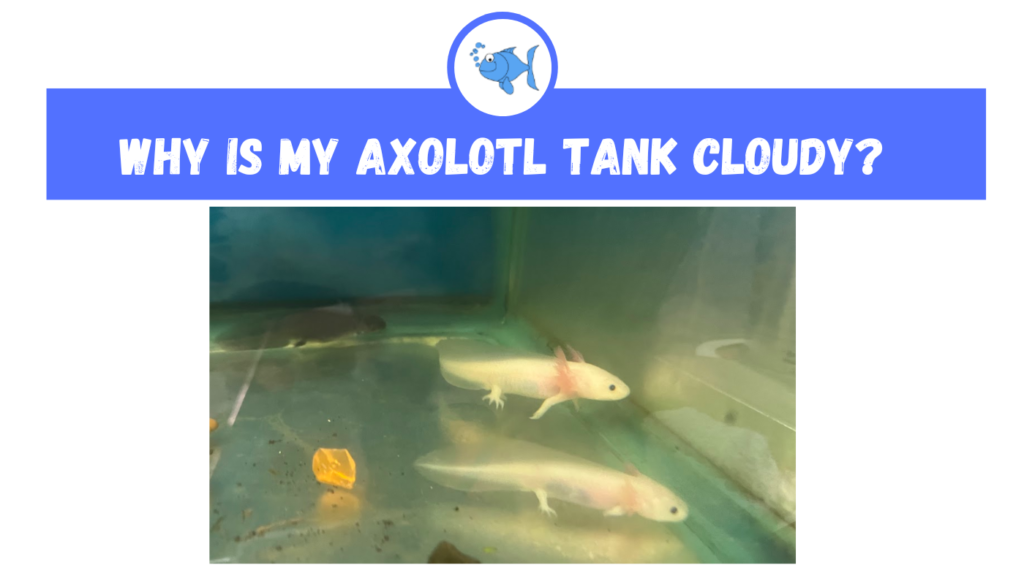Axolotls are one of the coolest exotic fish species on the market. If you have one, you most likely want a clear fish tank that makes it easy to observe them. Therefore, it can obviously be a pain if your tank water gets cloudy all of a sudden. This article will explain the main reasons why your Axolotl tank is cloudy.
Why is My Axolotl Tank Cloudy?
The main reasons your Axolotl tank is cloudy is because of bacterial bloom, poor filtration, water changes, or your substrate.
I will go into more detail below on each of the causes, and also provide ways to help your cloudy tank. Since axolotl’s don’t have great sight to begin with, it’s important to fix the cloudy tank as soon as possible so they don’t get stressed out.
Bacterial Bloom
Bacterial bloom is a tank condition that is very common in fish tanks. It can occur from a variety of things, but it essentially means your water has seen a rapid increase in bacterial colonies. Some of the main instances that cause bacterial bloom include:
- New fish tanks that haven’t undergone the nitrogen cycle
- Rapid increase in nutrients, usually caused by uneaten food, plant decay, or untreated water
- Excessive plant growth
Bacterial bloom will cause the water in your Axolotl fish tank to get very cloudy. In some instances, it can give your water a yellow or greenish tint.
There are multiple ways to deal with bacterial bloom in your Axolotl fish tank. If you have a new fish tank, I suggest just giving it some time. The water might clear up after a couple of days.
If the eater doesn’t clear up in a day or two, or your fish tank isn’t new, I suggest you use this cloudy water treatment. It works like magic.

If it still doesn’t settle, you should perform more frequent water changes. You can also add some water clearing solutions which can help balance the bacteria levels in your fish tank.
You can help prevent bacterial bloom from occurring in the future by following the steps below.
- Don’t overfeed your fish, and remove any uneaten food
- Remove any decaying parts of your live plants
- Wash all of your Axolotl’s food before you put them in the tank
To learn more, you can check out my guide on how to get rid of bacterial bloom in a fish tank.
Now that you’ve learned about Bacterial Bloom, let’s explore some other reasons why your Axolotl tank is cloudy.
Poor filter
An underpowered filter, or the absence of a filter at all, can certainly lead to a cloudy tank. You need a filter that can collect all of the waste in your tank before it can decay and emit harmful chemicals. It is important that you have a strong fish tank filter that is powerful enough for the size of your tank.
It is also important not to forget about filter maintenance. Most filters need to be either manually cleaned or replaced every couple of months.
Sometimes, if your filter is a couple years old, it might just be at the end of its life. For this reason, I suggest you replace your entire filter every couple of years. A properly working filter is essential to maintaining a clear Axolotl tank.
While axolotls can’t get depressed, a dirty tank will certainly stress them out. You can learn more in my article on how long can an axolotl go without a filter.
Water changes
Your Axolotl tank will also be cloudy if you don’t do the correct number of water changes. I suggest that you do a 20% water change every other week. This will help prevent the buildup of toxic elements and replenish the tank with oxygen.
Most of the time, cloudy water will be the result of infrequent water changes. However, doing too many water changes can also lead to a cloudy tank. This is certainly the case if you use tap water, which is high in chlorine. If you do use tap water, you must treat it with a conditioner before you put it in.
Substrate
Lastly, your Axolotl tank can be cloudy because of the substrate you use. If you have a substrate that is very dusty, it can accumulate and cause the water to get very cloudy. Coral and rocks are particularly dusty substrates, so this is definitely a possibility if you have them in your tank.
You can help reduce the dust in your Axolotl tank by washing this substrate before you put it in your tank. However, even cleaning this substrate can’t get rid of all the dust, and the substrate might remove dust if it is moved around a lot.
Other ways to prevent a cloudy Axolotl tank
Aside from the one discussed above there are additional ways you can help prevent a cloudy Axolotl tank. For starters, it is important that you don’t overcrowd your tank. A general rule when it comes to Axolotl tank size is that you should aim to have at least 10-15 gallons for each Axolotl. Overcrowding can cause excessive waste, as well as stress for your Axolotl.
It is also important that you don’t overfeed your axolotl, as excess food can contribute to a cloudy tank. On the flip side, you should not go a long time without feeding your axolotl as it is dangerous for their health.
Adding live plants can also help prevent a cloudy tank. It helps neutralize the water chemistry and helps add oxygen to the water.
There are also UV clarifier filters that can help remove the cloudiness in your tank. They specifically attack bacteria and algae.
Lastly, I recommend that you regularly test the water chemistry of your water. It can be helpful to catch any imbalances early before they get too out of hand.
